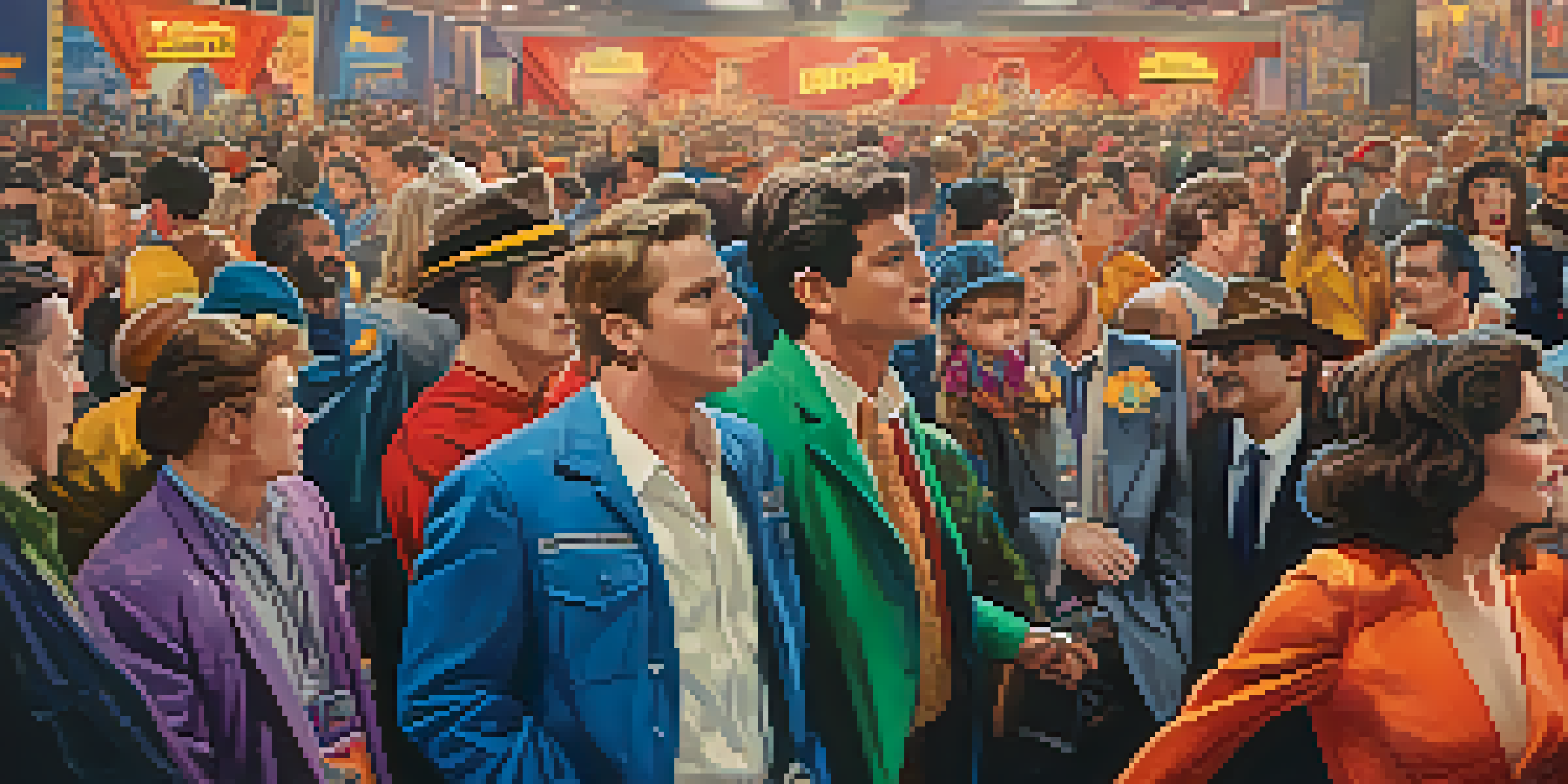Characteristics of Cult Films: What Sets Them Apart?

Passionate Fanbase: The Heart of Cult Films
One of the most defining characteristics of cult films is their passionate fanbase. These films often develop a dedicated following that transcends traditional audience engagement, leading to fan conventions, screenings, and discussions. Think of movies like 'The Rocky Horror Picture Show,' where audiences dress up and act out scenes; this communal experience deepens the connection to the film.
Cult movies are like a secret handshake among those in the know.
Fans often forge a sense of identity through their love for these films, creating a subculture that celebrates the uniqueness of the movie. This group dynamic not only fuels the film's longevity but also provides a platform for fans to share their interpretations and reactions. It's this enthusiasm that turns a regular film into a cult classic, allowing it to thrive long after its initial release.
Moreover, the film's ability to resonate on a personal level with its audience fosters a sense of belonging. Fans might bond over shared quotes, inside jokes, or even memes derived from their favorite scenes. This interaction keeps the film alive in popular culture and cements its status as a cult classic.
Unique Themes and Storytelling: Breaking the Mold
Cult films often explore unconventional themes and narratives that challenge mainstream storytelling. They might tackle taboo subjects, present bizarre plot twists, or experiment with non-linear storytelling, making them stand out. For instance, films like 'Eraserhead' showcase surrealism in a way that leaves viewers both puzzled and intrigued.

This willingness to push boundaries invites audiences to think critically and engage with the material on a deeper level. Unlike traditional films that may follow a predictable structure, cult films often embrace the strange or absurd, inviting a sense of adventure in the viewing experience. As a result, they become a canvas for artistic expression, encouraging filmmakers to take risks.
Passionate Fanbase Drives Cult Films
Cult films cultivate a dedicated following that transforms viewing into a communal experience, enhancing their longevity and cultural significance.
Furthermore, the uniqueness of these films often leads to varied interpretations, fueling discussions and debates among fans. This open-ended approach to storytelling encourages multiple viewings, as audiences may discover new layers and meanings each time they watch, enhancing the cult film's allure.
Memorable Characters: Quirky and Iconic
Cult films are known for featuring memorable and often eccentric characters that leave a lasting impression. These characters can range from the lovable oddball to the unsettling anti-hero, but they all share a certain flair that sets them apart from typical film characters. For example, who can forget the iconic performance of David Bowie as Jareth in 'Labyrinth'?
The beauty of cult films is that they are not afraid to explore the darker sides of life and offer a mirror to society's absurdities.
These characters often embody traits that resonate with niche audiences, creating a connection that is both relatable and aspirational. They may reflect the outsider experience, allowing viewers to see themselves in these unique personas. This relatability is what makes cult films appealing, as they often offer a safe space for audiences to embrace their quirks and eccentricities.
As fans latch onto these characters, they often quote their lines, mimic their mannerisms, or even dress like them, further solidifying their cult status. This character-driven approach not only enhances the film's memorability but also fosters a community of fans who celebrate these larger-than-life personas together.
Aesthetic Choices: Visual and Auditory Elements
The aesthetic of cult films often defies conventional standards, embracing bold visual and auditory elements that create a distinct atmosphere. Whether through striking cinematography, unconventional editing, or an eclectic soundtrack, these films craft a unique sensory experience. For instance, the vibrant colors and experimental visuals in 'Pink Flamingos' contribute to its outrageous charm.
These artistic choices not only set the mood but also enhance the storytelling, allowing viewers to feel the emotions and themes on a visceral level. The music, too, plays a crucial role; cult films often feature soundtracks that become iconic in their own right, further ingraining the film into popular culture. Think of how the soundtrack of 'The Breakfast Club' still resonates with audiences today.
Unique Themes Challenge Norms
These films often explore unconventional themes and narratives, inviting audiences to engage deeply and embrace the absurd.
This distinctive aesthetic often becomes a hallmark of cult films, allowing fans to recognize and appreciate the movie's style even after years have passed. Ultimately, these visual and auditory elements elevate the film beyond mere entertainment, transforming it into an art form that invites analysis and discussion.
Subversive Humor: Laughing at the Norms
Cult films frequently employ subversive humor that challenges societal norms and expectations. This unique brand of comedy often embraces the absurd, allowing filmmakers to critique cultural taboos and conventions. Movies like 'The Big Lebowski' exemplify this with their offbeat humor that appeals to those looking for something different from mainstream comedies.
This humor often resonates with audiences who appreciate wit that pushes boundaries and encourages them to think critically about the world around them. By laughing at societal standards, cult films create a space for viewers to question and reflect on their own beliefs and experiences. This connection fosters a deeper understanding of the film's themes while providing a much-needed dose of laughter.
Moreover, the shared appreciation for this type of humor creates camaraderie among fans. Inside jokes and memorable quotes often become rallying points for discussions, helping to cultivate a community that thrives on wit and irreverence. In a world that can sometimes take itself too seriously, this kind of humor offers a refreshing escape.
Nostalgia and Camp: Embracing the Unconventional
Many cult films tap into nostalgia, often celebrating eras, styles, or genres that evoke fond memories. This sense of nostalgia can be both comforting and alluring, drawing viewers back to a time when they first discovered the film. Movies like 'Clueless' not only embody the fashion and culture of the 90s but have also become staples in pop culture references.
Alongside nostalgia, the camp aesthetic plays a significant role in defining cult films. Camp refers to an exaggerated and often humorous style that revels in its own absurdity. This approach invites audiences to appreciate the film for its quirks rather than dismiss them as flaws, allowing viewers to embrace the film's charm wholeheartedly.
Cult Status Grows Over Time
Many cult films initially struggle for recognition but eventually gain a devoted fanbase that celebrates their distinct qualities.
By combining nostalgia and camp, cult films cultivate a unique viewing experience that invites audiences to laugh, reminisce, and celebrate the unconventional. This combination keeps the films relevant across generations, as new audiences discover and appreciate the charm of these cinematic gems.
Cult Status: The Journey from Flop to Fame
Interestingly, many cult films didn't achieve mainstream success upon their initial release. Instead, they often found their audience through grassroots movements, word-of-mouth, or midnight screenings, slowly building a following over time. For example, 'Donnie Darko' initially struggled at the box office but later gained a devoted fanbase that propelled it to cult status.
The journey to cult status often involves a transformation of perception, where films that were once dismissed as failures are re-evaluated and celebrated for their unique qualities. This shift can be attributed to the passion of fans who champion these films, creating a sense of community that fosters ongoing discussions and screenings. As more people share their love for the film, its reputation grows.

Ultimately, the journey from obscurity to cult fame illustrates the unpredictable nature of film appreciation. It serves as a reminder that sometimes, what seems like a flop can resonate deeply with a specific audience, leading to a lasting legacy that defies conventional expectations. This phenomenon emphasizes the importance of community and shared experiences in shaping a film's identity.